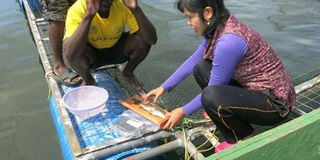Scientists find formula to rear Nile perch in ponds and cages

Dr Helen Marcial from Japan’s Nagasaki University shows a farmer how to rear Nile perch in cages in Lake Victoria. PHOTO | ISAIAH ESIPISU
What you need to know:
- “Nile perch rearing in cages is sustainable because you do not need to feed the fish using feeds as it is the case with other species like tilapia,” said Dr Helen Marcial, an aquaculture expert from Nagasaki University.
- The researchers have made four cages in Magenta Island, Sika Beach each measuring 5 by 4 by 2 metres hosting 10,000 Nile perch fingerlings.
A mature Nile perch should weigh about 5kg. - The scientist further said that while keeping Nile perch in ponds, one should harvest when they are still smaller, unlike in cages where they can be left to grow big.
The Nile perch, locally known as mbuta, is one of the most sought-after fish species in Lake Victoria due to its fleshy body and the ever-growing demand in the export market.
The fish further eats other smaller fish species in the lake, therefore, making itself vulnerable to fishermen.
Its stock has, thus, been dwindling at an alarming rate, but scientists are out to arrest the situation.
The scientists from Maseno University in collaboration with their counterparts from Japan’s Nagasaki University, have come up with a way that enables farmers rear the fish either using floating cages in the lake, or in fishponds.
Nile perch can grow to up to 200kg (weight of two mature men), and feeds on other species of fish. Its carnivorous diet and massive body size had, therefore, made it difficult for farmers to think of its domestication.
In the cage aquaculture, the Nile perch is reared in enclosed spaces inside the lake. The cages are built using metal bars, wire mesh, and nets, with ordinary plastic cans to keep them afloat and to act as wave breakers. Normally, farmers place the cages strategically inside the lake, and feed the fish daily.
But with the carnivorous Nile perch, they only need to find a way of attracting other smaller fish into the cage. One way to doing this is by fitting the cages with lights.
“Nile perch rearing in cages is sustainable because you do not need to feed the fish using feeds as it is the case with other species like tilapia,” said Dr Helen Marcial, an aquaculture expert from Nagasaki University.
Since the Nile perch is bigger, their cages have nets that allow smaller fish from the surrounding to freely swim in and out, which turns out to be food for the bigger fish.
The researchers have made four cages in Magenta Island, Sika Beach each measuring 5 by 4 by 2 metres hosting 10,000 Nile perch fingerlings.
A mature Nile perch should weigh about 5kg.
OVER-REPRODUCTION
In pond farming, Dr Marcial further noted that the Nile perch is kept in the same structure with other smaller fish species. “In this case, we allow both sexes of small fish species so that they can reproduce in plenty, thus naturally providing food for the Nile perch. Ponds where the Nile perch is kept, however, must be bigger,” she told Seeds of Gold.
Under normal circumstances when rearing fish species like tilapia, farmers go for same sex to avoid over-reproduction that makes management a tough task. But in the Nile perch fishponds, the carnivorous fish species prey on the reproduced fingerlings, making it possible to keep the parent stock population in control, while at the same time providing food for the bigger fish.
The scientist further said that while keeping Nile perch in ponds, one should harvest when they are still smaller, unlike in cages where they can be left to grow big.
According to the Lake Victoria Fisheries Organisation, around 75 per cent of the Nile perch harvested is exported, mainly to Europe, the US and the Middle East.
“The Nile perch constitutes 90 per cent of the fish exports from the lake,” said Jonathan Munguti, the Head of the Aquaculture Division at the Kenya Marine and Fisheries Research Institute (KMFRI).
Given the fish’s carnivorous nature, the Nile perch has preyed on many other types of fish species making some nearly extinct. Notably, the fish has wiped out nearly half of the 500-plus endemic native species of Lake Victoria cichlids, which are colorful fish that once thrived in the lake basin.
“Introduction of new aquaculture technologies will definitely help us salvage the Nile perch that we may soon lose,” said Munguti, noting KMFRI is in the process of establishing an International Nile Perch Research Centre to be based in Kisumu, where it will explore means of protecting the species.
The technology to farm the Nile perch was introduced through Lake Victoria Comprehensive Research for Development (LAVICORD), a university-driven project to address over exploitation of wild fisheries resources, aquaculture technologies and the lake pollution.
“Our preliminary research findings show that cage aquaculture is a viable business on Lake Victoria, far better than use of canoes,” said Prof Wellington Otieno, a lecturer at Maseno University and the Principal Adviser for LAVICORD project.





